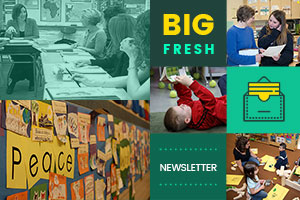Too often we underestimate the power of a touch, a smile, a kind word, a listening ear, an honest compliment, or the smallest act of caring, all of which have the potential to turn a life around.
Leo Buscaglia
Rosie was my son’s lizard, a bearded dragon. She was old and she died. Sam, being sentimental, insisted that the entire family gather in the backyard for Rosie’s burial and eulogy.
After she was buried, Sam said, “I have a few words to say.” Bless his older siblings for remaining somber for the funeral and rolling their eyes only when Sam wasn’t looking. Sam took a deep breath and delivered a serious eulogy:
Rosie lived a good life, completing almost her entire bucket list. She went for a ride on a race car and even drifted in Hallway Speedway. She surfed warm waves on her customized surfboard in Bathtub Bay. She jumped on the Trampoline Tavern. Her last day was spent taking a walk in the sunshine, reading books, and watching the world go by from the rocker on the front porch. Let us all live like Rosie, with some adventure and lots of time with those who matter most.
Sam blinked back tears, and we stood in silence. Then Jordan clapped, and one by one each of us joined in applause. There we stood in the moonlight on a school night, clapping around a dead lizard’s grave. “Thanks, guys,” Sam said, and hugged each of us as a conclusion to the funeral.
It was a bizarre experience, but one that I want to have happen more often. Not that I need to attend more lizard funerals. (Nor does anyone else, for that matter.) What we do need is to become aware of the things that are important to others, and give them time to explain why these things matter in their lives. It doesn’t take long, and the only requirement is a willingness to listen. Our classrooms are filled with kids who lose pets, hit home runs, and finish new favorite books. Let’s take the time for small acts of kindness that have great impact on the lives of students.
This week we look at the power of rereading and retelling. Plus more as always — enjoy!
Ruth Ayres
Contributor, Choice Literacy
Ruth Ayres is a full-time writing coach for Wawasee School District in northern Indiana. She blogs at Ruth Ayres Writes and is the author of the new book Enticing Hard-to-Reach Writers, available through Stenhouse Publishers.
Free for All
[For sneak peeks at our upcoming features, quotes and extra links, follow Choice Literacy on Twitter: @ChoiceLiteracy or Facebook: http://www.facebook.com/ChoiceLiteracy or Pinterest: http://pinterest.com/choiceliteracy/]
Retelling is an essential skill for readers, and it’s one that is crucial for success on most proficiency exams too. Clare Landrigan and Tammy Mulligan share strategies and sample lessons for teaching retelling:
http://www.choiceliteracy.com/articles-detail-view.php?id=865
Katherine Sokolowski uses a fascinating picture book to build close reading skills with her fifth graders. The key is selecting a text that holds up well through multiple readings:
http://www.choiceliteracy.com/articles-detail-view.php?id=2251
By this point in the year, teachers are worried about the progress of at least a few children in their classes. Cathy Mere considers what it means to truly meet readers where they are, even if we are concerned about growth:
http://reflectandrefine.blogspot.com/2017/10/meeting-learners-where-they-are.html
Are goals getting in the way of progress in your classroom? This counterintuitive research may make you rethink the place of goal-setting in learning:
http://www.bbc.com/capital/story/20171117-why-we-should-all-give-up-on-goals-already
For Members Only
We’ve all had that student — the one who blurts out a misreading of a text, only to have classmates agree with the analysis. Christy Rush-Levine explains how she uses “first-, second-, and third-draft readings” to help her middle school students develop stronger comprehension skills:
http://www.choiceliteracy.com/articles-detail-view.php?id=2897
Lifelong readers often have books they love to reread, sometimes more than once. But young readers can also get into ruts. Jennifer Schwanke explores when rereading is fine for students, and when it should be challenged. She includes a series of questions for teachers to use when conferring with children who are rereading favorite books:
http://www.choiceliteracy.com/articles-detail-view.php?id=2529
In this week’s video, Katrina Edwards uses the children’s books They All Saw a Cat and Be a Friend for a minilesson with her first-grade students on how to retell stories with a partner during reading workshop:
http://www.choiceliteracy.com/articles-detail-view.php?id=2724
Stella Villalba explains why rereading is especially useful for young English language learners, and shares some simple strategies for integrating more rereading strategies into reading and writing workshops:
http://www.choiceliteracy.com/articles-detail-view.php?id=2336
In an encore video, Stella scaffolds the language development of her first- and second-grade English language learners during read-aloud by highlighting vocabulary and providing a tool to assist with a partner retelling activity:
http://www.choiceliteracy.com/articles-detail-view.php?id=1501
That’s all for this week!



